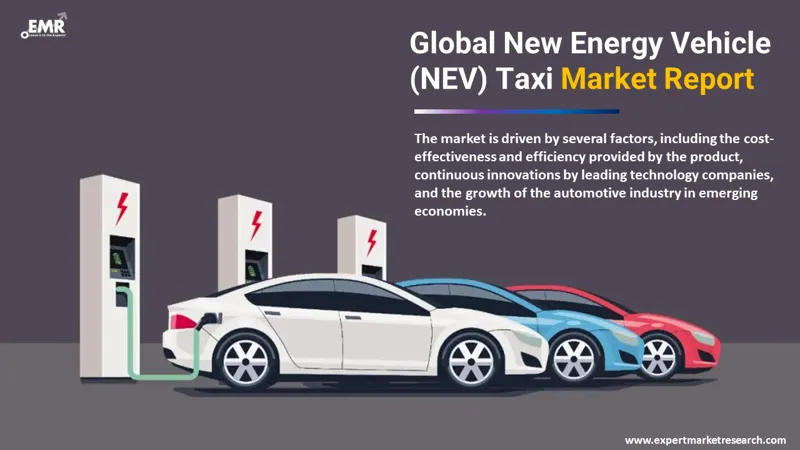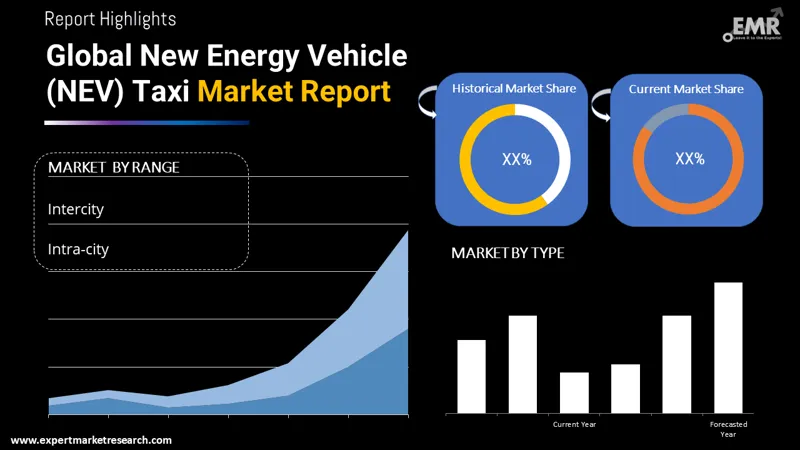
Consumer Insights
Uncover trends and behaviors shaping consumer choices today
Procurement Insights
Optimize your sourcing strategy with key market data
Industry Stats
Stay ahead with the latest trends and market analysis.
The global New Energy Vehicle (NEV) Taxi market is expected to grow at a CAGR of 1.80% during the period 2026-2035. Electrification of transport would be a key element in checking global carbon dioxide emissions. Several countries are continually making efforts towards widespread electric vehicle adoption, and investing in required infrastructure.
Base Year
Historical Period
Forecast Period
Compound Annual Growth Rate
1.8%
2026-2035
*this image is indicative*
The Chinese government has formulated multiple policies to promote the new energy vehicle (NEV) industry. North America, Europe and Asia are likely to be key markets.
The new energy vehicle (NEV) industry witnessed significant growth in 2021. Such growth has made new energy vehicles (NEVs) a lucrative proposition for conventional vehicle manufacturers, emergent new energy vehicle (NEV) companies, and tech giants, making them compete for software R&D, new business models, and branding. The new energy vehicle (NEV) industry has been witnessing significant investment, with nearly $400 billion being invested into the sector over the last decade. Robust global growth and prosperous development have drawn the interest of vehicle manufacturers, rising new energy vehicle (NEV) companies, and tech players.

Read more about this report - REQUEST FREE SAMPLE COPY IN PDF
Countries across the world are looking to adopt new energy as a strategic development direction and contribute towards the green transformation of the automotive sector. The European Union, for example, has committed to decrease greenhouse gas emissions by at least 55% by 2030. USA seeks to make half of all cars new energy vehicle (NEVs) by 2030. Changing climate, policy regulations, and factors including an ageing global population, carbon emissions, increasing urbanisation, growing middle-class and increasing wealth gap are likely drivers of new energy vehicle (NEVs).
Advancements in technology, growing adoption of key technologies, and increasing consumer interest in new energy vehicles (NEVs) are vital drivers of the global new energy vehicle (NEV) taxi market. Technological advances are expected to further decrease the production cost for electric vehicles. Further, a balance could be expected in demand and supply with better customer recognition and enhanced manufacturing capacities.
Electronics and software are important parts of vehicles today. As compared to conventional vehicle producers, emergent new energy vehicle (NEV) manufacturers have greater software capabilities; such companies focus greatly on R&D, software algorithm development and electronic components. Moreover, many executives in these companies are originally from technology or internet companies. With advancements in the Internet, cars have been pushed beyond their purpose of just mobility; green technologies, intelligence and technology, enhanced charging facilities, and range capabilities are likely to be key areas of concern for new energy vehicle (NEV) brands in times to come. These factors are expected to drive the global new energy vehicle (NEV) taxi market.

Read more about this report - REQUEST FREE SAMPLE COPY IN PDF
The EMR’s report titled “New Energy Vehicle (NEV) Taxi Market Report and Forecast 2026-2035” offers a detailed analysis of the market based on the following segments:
By type, the market is segmented into:
By range, the market is classified into:
By region, the market is divided into:
The report presents a detailed analysis of the following key players in the global New Energy Vehicle (NEV) Taxi market, looking into their capacity, and latest developments like capacity expansions, plant turnarounds, and mergers and acquisitions:
The EMR report gives an in-depth insight into the industry by providing a SWOT analysis as well as an analysis of Porter’s Five Forces model.




*While we strive to always give you current and accurate information, the numbers depicted on the website are indicative and may differ from the actual numbers in the main report. At Expert Market Research, we aim to bring you the latest insights and trends in the market. Using our analyses and forecasts, stakeholders can understand the market dynamics, navigate challenges, and capitalize on opportunities to make data-driven strategic decisions.*
Get in touch with us for a customized solution tailored to your unique requirements and save upto 35%!
The market is estimated to grow at a CAGR of 1.80% between 2026 and 2035.
The major regions in the industry are North America, Latin America, the Middle East and Africa, Europe, and the Asia Pacific.
An electric vehicle is a one of the most popular types of new energy vehicle which is powered by electricity.
The future of new energy vehicles is promising as these vehicles are easy to operate, along with the on-going technological advancements in the battery technology. The favourable government policies encouraging the electrification of vehicles are further propelling the market scope.
The major drivers of the market include the cost-savings and efficiency offered by the product, growing innovations by the tech-giants, and thriving automotive industry across the emerging economies.
The transition towards smart mobile applications such as Ola and Uber and the growing need to reduce emissions are the key trends in the market.
Battery electric vehicle (BEV), plug-in hybrid electric vehicle (PHEV), and hybrid electric vehicle (HEV) are the different segments based on type in the market.
Intercity and Intra-city is the segmentation of the market based on range.
The major players in the industry are Uber Technologies Inc., Lyft Inc., Electric Cab North America, Blu-Smart Mobility Pvt. Ltd., and London EV Company Ltd., among others.
Explore our key highlights of the report and gain a concise overview of key findings, trends, and actionable insights that will empower your strategic decisions.
| REPORT FEATURES | DETAILS |
| Base Year | 2025 |
| Historical Period | 2019-2025 |
| Forecast Period | 2026-2035 |
| Scope of the Report |
Historical and Forecast Trends, Industry Drivers and Constraints, Historical and Forecast Market Analysis by Segment:
|
| Breakup by Type |
|
| Breakup by Range |
|
| Breakup by Region |
|
| Market Dynamics |
|
| Competitive Landscape |
|
| Companies Covered |
|
Datasheet
One User
USD 2,499
USD 2,249
tax inclusive*
Single User License
One User
USD 3,999
USD 3,599
tax inclusive*
Five User License
Five User
USD 4,999
USD 4,249
tax inclusive*
Corporate License
Unlimited Users
USD 5,999
USD 5,099
tax inclusive*
*Please note that the prices mentioned below are starting prices for each bundle type. Kindly contact our team for further details.*
Flash Bundle
Small Business Bundle
Growth Bundle
Enterprise Bundle
*Please note that the prices mentioned below are starting prices for each bundle type. Kindly contact our team for further details.*
Flash Bundle
Number of Reports: 3
20%
tax inclusive*
Small Business Bundle
Number of Reports: 5
25%
tax inclusive*
Growth Bundle
Number of Reports: 8
30%
tax inclusive*
Enterprise Bundle
Number of Reports: 10
35%
tax inclusive*
How To Order

Select License Type
Choose the right license for your needs and access rights.

Click on ‘Buy Now’
Add the report to your cart with one click and proceed to register.

Select Mode of Payment
Choose a payment option for a secure checkout. You will be redirected accordingly.
Gain insights to stay ahead and seize opportunities.

Get insights & trends for a competitive edge.

Track prices with detailed trend reports.

Analyse trade data for supply chain insights.

Leverage cost reports for smart savings

Enhance supply chain with partnerships.

Connect For More Information
Our expert team of analysts will offer full support and resolve any queries regarding the report, before and after the purchase.
Our expert team of analysts will offer full support and resolve any queries regarding the report, before and after the purchase.
We employ meticulous research methods, blending advanced analytics and expert insights to deliver accurate, actionable industry intelligence, staying ahead of competitors.
Our skilled analysts offer unparalleled competitive advantage with detailed insights on current and emerging markets, ensuring your strategic edge.
We offer an in-depth yet simplified presentation of industry insights and analysis to meet your specific requirements effectively.
Share